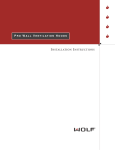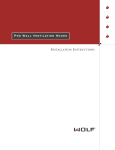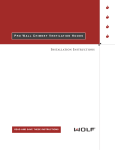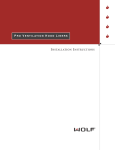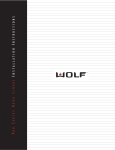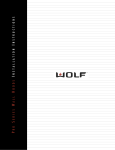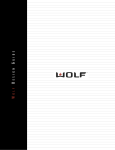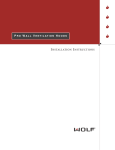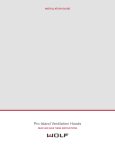Download Wolf 1200 Troubleshooting guide
Transcript
C O O K T O P V E N T I L AT I O N H O O D S I NSTALLATION I NSTRUCTIONS As you follow these instructions, you will notice WARNING and CAUTION symbols. This blocked information is important for the safe and efficient installation of Wolf equipment. There are two types of potential hazards that may occur during installation. signals a situation where minor injury or product damage may occur if you do not follow instructions. states a hazard that may cause serious injury or death if precautions are not followed. Another footnote we would like to identify is IMPORTANT NOTE: This highlights information that is especially relevant to a problemfree installation. WOLF ® is a registered trademark of Wolf Appliance Company, LLC W O L F C O O K TO P V E N T I L AT I O N H O O D S I N S TA L L AT I O N R E Q U I R E M E N T S B E F O R E YO U S TA RT IMPORTANT NOTE: This installation must be completed by a qualified installer or Wolf authorized service center technician. IMPORTANT NOTE: Wolf cooktop wall and island hood are recommended for use with Wolf electric and gas cooktops and integrated modules. They are NOT recommended for use with Wolf dual fuel ranges, gas ranges and rangetops. Any violation of this application may void your warranty for one or both products. Installer: Please read the entire Installation Instructions prior to installation. Save these instructions for the local inspector’s reference, then leave them with the homeowner. Homeowner: Please read and keep these instructions for future reference and be sure to read the entire Use & Care Information prior to use. Any questions or problems about the installation should be directed to your Wolf dealer or Wolf Appliance Company, LLC at 800-332-9513. You can also visit our website at wolfappliance.com. IMPORTANT NOTE: This appliance must be installed in accordance with National Electrical Codes, as well as all state, municipal and local codes. The correct voltage, frequency and amperage must be supplied to the appliance from a dedicated, grounded circuit which is protected by a properly sized circuit breaker or time delay fuse. The proper voltage, frequency, and amperage ratings are listed on the product rating plate. Record the model and serial numbers before installing the cooktop ventilation hood. Both numbers are listed on the rating plate, located on the inside left-hand wall of the hood, above the filter. Proper installation is the responsibility of the installer. Product failure due to improper installation is not covered under the Wolf Warranty. Refer to the Cooktop Ventilation Hoods Use & Care Information for warranty details, or visit the Contact / Help section of our website, wolfappliance.com. C O N TA C T I N F O R M AT I O N Wolf Customer Service: 800-332-9513 Website: wolfappliance.com Make sure you have the tools and materials necessary for proper installation. Any required service must be performed by a Wolf authorized service center. Wolf is not responsible for service required to correct a faulty installation. IMPORTANT NOTE: Wolf cooktop wall and island hoods are shipped without the blower assembly. Wolf internal or remote blower assemblies are available; refer to page 12. Use only a Wolf blower with the cooktop ventilation hood. Model Number Serial Number 3 W O L F C O O K TO P V E N T I L AT I O N H O O D S OV E R A L L D I M E N S I O N S 18" 12" (457) (305) MODEL CTWH30 Overall Width 30" (762) 4 1/2" min Overall Height (excluding chimney) (114) 6 7/8" (175) Overall Height (including chimney) 30 1/2" (775) 30 1/2" TO 48 1/2" 19 1/8" (775 - 1232) OVERALL HEIGHT (486) 48 1/2" (1232) Max Height (full extension) Overall Depth 6 7/8" (175) 30" (762) OVERALL WIDTH 21" (533) OVERALL DEPTH Shipping Weight (shell only) 21" (533) 85 lbs (39 kg) Dimensions may vary to –+ 1/8" (3). 1 9/16" (40) Model CTWH30 Wall Hood MODEL CTWH36 35 7/16" (900) Overall Width 18" 12" (457) (305) 9 1/4" (235) Overall Height (excluding chimney) 4 5/16" min (110) Overall Height (including chimney) 3211/16" (830) Max Height (full extension) 32 11/16" TO 50 7/8" 19 1/8" (830 - 1292) OVERALL HEIGHT (486) 50 7/8" (1292) Overall Depth Shipping Weight (shell only) 21" (533) 100 lbs (45 kg) Dimensions may vary to –+ 1/8" (3). 9 1/4" (235) 35 7/16" (900) OVERALL WIDTH 21" (533) OVERALL DEPTH 1 9/16" (40) Model CTWH36 Wall Hood 18" 12" (457) (305) MODEL IH4227 Overall Width 42" (1067) Overall Height (excluding chimney) 9 1/4" (235) Overall Height (including chimney) 33 9/16" (853) Max Height (full extension) 47 1/16" (1195) 5" min (127) Overall Depth Shipping Weight (shell only) 33 9/16" TO 47 1/16" 19 5/16" (853 - 1195) OVERALL HEIGHT (491) 27" (686) 110 lbs (50 kg) Dimensions may vary to –+ 1/8" (3). 9 1/4" (235) 42" (1067) OVERALL WIDTH 27" (686) OVERALL DEPTH 1 9/16" (40) Model IH4227 Island Hood 4 Dimensions in parentheses are in millimeters unless otherwise specified. I N S TA L L AT I O N I N S T R U C T I O N S HOOD P L AC E M E N T Wolf cooktop wall and island hoods come with a telescopic chimney flue that allows you to reach a ceiling height of 8' (2.4 m) to 9' (2.7 m) with a finished look. A flue extension to accommodate 10' (3 m) ceilings is available. Refer to page 12 for optional accessories. C A L C U L AT E C H I M N E Y F L U E H E I G H T Installation of the cooktop wall or island hood should be 24" (610) to 30" (762) from the bottom of the hood to the countertop. 3) Then determine the minimum C value (distance from countertop to bottom of hood). Refer to the chart below for ceiling heights from 8' (2.4 m) to 9' (2.7 m). Dimension C must be greater than 24" (610) and less than 30" (762). 1) First measure A (total kitchen height from finished floor to finished ceiling height). 2) Next measure B (height from finished floor to countertop). IMPORTANT NOTE: 8' (2.4 m) ceilings may not permit installation of the wall or island hood at 30" (762) above the countertop. ACCESSORIES Optional accessories are available through your Wolf dealer. To obtain local dealer information, visit the Locator section of our website, wolfappliance.com. 4) To determine the upper flue section height: E=A-(C+B+D). To determine placement of the wall or island hood, you must calculate the height of the telescopic chimney flue. Refer to the chart and illustration below. IMPORTANT NOTE: If dimension E falls between 0" (0) and 1/2" (13), you will need to modify the flue to affix to the flue attachment brackets. For ease of installation, Wolf recommends that dimension E be no less than 1/2" (13). IMPORTANT NOTE: Both sections of the telescopic chimney flue must be installed in order for the chimney to be lifted for service. Model CTWH30 Wall Hood (E) UPPER FLUE TOTAL (A) (B) (C) (D) (E) (F) 96" (2438) 36" (914) 24" (610) min 30 1/2" (775) 5 1/2" (140) 48 1/2" (1232) 96" (2438) 36" (914) 0" 48 1/2" (1232) 108" (2743) 36" (914) 24" (610) min 30 1/2" (775) 17 1/2" (445) 48 1/2" (1232) 108" (2743) 36" (914) 30" (762) max 30 1/2" (775) 11 1/2" (292) 48 1/2" (1232) 29 1/2" (749) max 30 1/2" (775) HEIGHT TO CEILING (F) MAXIMUM HEIGHT OF HOOD (D) BOTTOM OF HOOD TO MINIMUM FLUE EXTENSION Model CTWH36 Wall Hood (A) (B) (C) (D) (E) (F) 96" (2438) 36" (914) 24" (610) min 32 11/16" (830) 3 5/16" (84) 50 7/8" (1292) 96" (2438) 36" (914) 0" 50 7/8" (1292) 27 5/16" (694) max 32 11/16" (830) 108" (2743) 36" (914) 24" (610) min 32 11/16" 108" (2743) 36" (914) 30" (762) max 32 11/16" (830) (830) 15 7/16" (392) 50 7/8" (1292) 9 5/16" (237) 50 7/8" (1292) (A) TOTAL FLOOR TO CEILING HEIGHT (C) COUNTERTOP TO BOTTOM OF HOOD Model IH4227 Island Hood (A) (B) (C) (D) (E) (F) (853) 2 7/16" 26 7/16" (672) max 33 9/16" (853) 0" 47 1/16" (1195) 33 9/16" (853) 14 7/16" (367) 47 1/16" (1195) 33 9/16" (853) 8 7/16" (214) 47 1/16" (1195) 96" (2438) 36" (914) 24" (610) min 96" (2438) 36" (914) 108" (2743) 36" (914) 24" (610) min 108" (2743) 36" (914) 30" (762) max 33 9/16" (62) 47 1/16" (1195) (B) FLOOR TO COUNTERTOP HEIGHT Letters correspond to those in the illustration. 5 W O L F C O O K TO P V E N T I L AT I O N H O O D S WA L L H O O D I N S T A L L A T I O N I N S TA L L D U C T W O R K DUCTWORK INSTALLATION THROUGH ROOF ROOF CAP OR REMOTE BLOWER – TRANSITION FROM 8" (203) TO 10" (254) DUCT REQUIRED FOR REMOTE BLOWER To reduce the risk of fire, use only metal ductwork. 8" (203) ROUND DUCT IMPORTANT NOTE: Consult a qualified HVAC Engineer for specific ducting applications. WALL CAP OR REMOTE BLOWER CHIMNEY FLUE EXTENSION TELESCOPIC CHIMNEY FLUE DUCTWORK INSTALLATION THROUGH WALL 8" (203) ROUND ELBOW 8" (203) ROUND DUCT 8" (203) ROUND VERTICAL DISCHARGE 6 7/8" (175) OR 91/4" (235) CHIMNEY WALL HOOD 21" 24" TO 30" (535) (610–762) COUNTERTOP TO BOTTOM OF VENTILATION HOOD Decide where the ductwork will run between the hood and the outside. A straight, short duct run will allow the hood to perform more efficiently. Limit the number of elbows and transitions to as few as possible. Long duct runs, elbows and transitions will reduce the performance of the hood. Wolf recommends the maximum linear duct run be no greater than 50' (15 m). Always use metal ducting. Do not use flex ducting. IMPORTANT NOTE: All hoods must exhaust to the outdoors. IMPORTANT NOTE: There is a possibility of noise issues, when using a remote blower with a short duct run. Wolf recommends installing a backdraft damper in all installations. A backdraft damper is included with the hood. It is built into the transition from the hood to the duct run. In cold weather installations a backdraft damper is necessary to minimize the backflow of cold air into the room. Wall hood installation M O U N T I N G H A R DWA R E I N C L U D E D (10) Drywall anchors (10) Hood mounting screws .19" (5) x 1.5" (38) If you are not installing a remote blower, always install a roof or wall cap. Connect 8" (203) round metal ductwork to the cap and work back towards the hood location. Use duct tape to seal joints between ductwork sections. Local building codes may require the use of make-up air. Consult your local HVAC professional for specific requirements in your area. (2) Flue attachment screws .15" (4) x .37" (10) (2) Flue attachment brackets (2) Hood attachment brackets (4) Hood attachment screws .15" (4) x .37" (10) The wall hood mounting kit (803735) is also available from your Wolf Dealer. 6 To reduce the risk of fire and electric shock, install this ventilation hood only with a Wolf blower. Blower part numbers 801640, 801641, 801642, 801643, 801644, 801645 and 804701. Dimensions in parentheses are in millimeters unless otherwise specified. I N S TA L L AT I O N I N S T R U C T I O N S WA L L H O O D I N S TA L L A T I O N ELECTRICAL REQUIREMENTS I N S TA L L M O U N T I N G B R A C K E T S Wolf cooktop wall hoods require a separate, grounded 110/120 V AC, 60 Hz power supply. The service should have its own 15 amp circuit breaker. Locate the electrical supply with a minimum of 12" (305) of 120 V AC power cable within the shaded area shown in the illustration below. Construct wood wall framing that is flush with the interior surface of the wall studs. Make sure that the framing is centered in the hood installation location, and that the height of the framing will allow the mounting brackets to be secured to the framing within the dimensions shown in the illustration below. You must follow all National Electrical Code regulations. In addition, be aware of local codes and ordinances when installing your service. After the wall surface is finished, secure the mounting brackets to the framing using the dimensions shown. I N S TA L L T H E H O O D I N S TA L L B A C K S P L A S H If an optional backsplash is to be used, attach it to the finished wall. Secure the hood mounting brackets to the wall studs prior to installing the backsplash. Refer to page 12 for optional accessories. ACCESSORIES Optional accessories are available through your Wolf dealer. To obtain local dealer information, visit the Locator section of our website, wolfappliance.com. Hang the hood from the brackets through the rectangular cut-outs on the back of the hood. The cut-outs are larger than the brackets to allow for vertical and horizontal adjustment. Keep in mind that the bottom of the hood should be 24" (610) to 30" (762) above the countertop. Use height adjustment screws to adjust the hood vertically and the depth adjustment screws to adjust the hood horizontally. Secure the hood with additional mounting screws. If wall studs or framing are not available in the proper location, use the drywall anchors provided with the hood Framing Behind Drywall Rectangular Cutouts Mounting Brackets 6" (152) Mounting Brackets E 4" (102) Additional Mounting Screws 71/2" (190) (CTWH30) 71/2" (190) 30" OR 35 7/16" 9 3/8" (238) (762 or 900) (CTWH36) (CTWH30) 9 3/8" (238) Wall Framing (CTWH36) Electrical supply location Mounting bracket installation Hood installation 7 W O L F C O O K TO P V E N T I L AT I O N H O O D S WA L L H O O D I N S TA L L A T I O N I M P O R TA N T N OT E You must follow all National Electrical Code regulations. In addition, be aware of local codes and ordinances when installing your service. ELECTRICAL CONNECTIONS CONNECT DUCTWORK IMPORTANT NOTE: This ventilation hood must be properly grounded. This unit should be installed by a qualified electrician in accordance with all applicable national and local electrical codes. Use the screws and wall anchors provided to secure the upper brackets to the ceiling. Position the upper brackets based on the dimension of the telescopic chimney flue. Remove the cover from the rear electrical box. Remove the electrical box knockout that faces the hood's discharge collar. Use an 8" (203) round metal duct to connect the duct collar on the hood to the ductwork above. Use duct tape to make all joints secure and air tight. Insert 6" (152) of 120 V AC power cable through the knockout opening. Secure the cable to the electrical box with an appropriate connector. Connect the upper section of the telescopic chimney flue to the brackets with the screws provided. Make electrical connections. Connect black to black, white to white and green/yellow to green or bare wire. Refer to the illustration below. Nest the bottom of the telescopic chimney flue into the relief in the hood shell. Reinstall the electrical box cover and screws. Make sure that all wires are secure and that no wires are pinched between the cover and box. Refer to page 13 for internal blower installation guidelines and remote blower wiring. green/yellow to green or black to bare wire black 120 V AC rear power cable electrical box Screws TOP OF HOOD SHELL Electrical connections 8 Upper Brackets Fasten flue to hood and upper brackets and nest flue in hood relief discharge collar white to white HOOD FRONT Fasten upper brackets to ceiling and wall with screws (and anchors if necessary) Upper bracket installation Telescopic chimney flue installation I N S TA L L AT I O N I N S T R U C T I O N S I S L A N D H O O D I N S TA L L A T I O N I N S TA L L D U C T W O R K To reduce the risk of fire, use only metal ductwork. DUCTWORK INSTALLATION THROUGH ROOF ROOF CAP OR REMOTE BLOWER – TRANSITION FROM 8" (203) TO 10" (254) DUCT REQUIRED FOR REMOTE BLOWER 8" (203) ROUND DUCT IMPORTANT NOTE: Consult a qualified HVAC Engineer for specific ducting applications. Decide where the ductwork will run between the hood and the outside. A straight, short duct run will allow the hood to perform more efficiently. Limit the number of elbows and transitions to as few as possible. Long duct runs, elbows and transitions will reduce the performance of the hood. Wolf recommends the maximum linear duct run be no greater than 50' (15 m). Always use metal ducting. Do not use flex ducting. IMPORTANT NOTE: All hoods must exhaust to the outdoors. 8" (203) ROUND ELBOW 8" (203) ROUND ELBOW CHIMNEY FLUE EXTENSION EAVE VENT TELESCOPIC CHIMNEY FLUE DUCTWORK INSTALLATION THROUGH EAVE 8" (203) ROUND VERTICAL DISCHARGE 8" (203) ROUND DUCT 91/4" (235) CHIMNEY ISLAND HOOD 24" TO 30" (686) 27" (610 – 762) COUNTERTOP TO BOTTOM OF VENTILATION HOOD IMPORTANT NOTE: There is a possibility of noise issues, when using a remote blower with a short duct run. Wolf recommends installing a backdraft damper in all installations. A backdraft damper is included with the hood. It is built into the transition from the hood to the duct run. In cold weather installations a backdraft damper is necessary to minimize the backflow of cold air into the room. If you are not installing a remote blower, always install a roof or wall cap. Connect 8" (203) round metal ductwork to the cap and work back towards the hood location. Use duct tape to seal joints between ductwork sections. Local building codes may require the use of make-up air. Consult your local HVAC professional for specific requirements in your area. Island hood installation M O U N T I N G H A R DWA R E I N C L U D E D (4) Drywall anchors (4) Hood mounting screws .19" (5) x 1.5" (38) (4) Nuts M6 x 16 (4) Washers .25" (6) x .5" (13) To reduce the risk of fire and electric shock, install this ventilation hood only with a Wolf blower. Blower part numbers 801640, 801641, 801642, 801643, 801644, 801645 and 804701. Dimensions in parentheses are in millimeters unless otherwise specified. (4) Mounting screws .15" (4) x .37" (10) (4) Washers .17" (5) x .6" (16) 9 W O L F C O O K TO P V E N T I L AT I O N H O O D S I S L A N D H O O D I N S TA L L A T I O N ELECTRICAL REQUIREMENTS The Wolf cooktop island hood requires a separate, grounded 110/120 V AC, 60 Hz power supply. The service should have its own 15 amp circuit breaker. Locate the electrical supply with a minimum of 6' (1.8) of 120 V AC power cable on the ceiling through the top of the hood. You must follow all National Electrical Code regulations. In addition, be aware of local codes and ordinances when installing your service. I N S TA L L S U P P O R T S Y S T E M At the island hood installation location, install two-by-four or 3/4" (19) plywood cross framing between ceiling joists. Refer to the island hood mounting pattern dimensions below. Finish the ceiling surface. Be sure to mark the location of the ceiling joists and cross framing. Determine the desired orientation of the island hood. Note that the front designates the control side of the hood. Secure the upper half of the support frame to the joists and cross framing with four screws provided with your hood. Make sure that the screws are driven into the center of the joists and framing for maximum strength. Ensure the correct orientation of the support frame. Adjust the overall height of the support frame. Loosen and retighten the screws in the height adjustment slots as necessary. Refer to the illustration below. IMPORTANT NOTE: The hood height is 111/4" (286) from the support frame attachment point. The bottom of the hood must be 24" (610) minimum and 30" (762) maximum from the countertop. C O N N E C T D E C O R AT I V E F L U E Secure the upper telescopic chimney flue section to the upper support frame. Refer to the illustration below. Temporarily hold the lower telescopic chimney flue section over the upper flue section. Upper Flue TOP VIEW 61/2" 713/16" (165) (198) Height Adjustment Slots Mounting Screws Front of Support Frame 61/2" (165) 10 7/8" (276) Wide Mounting Flange Lower Flue FRONT OF HOOD Island hood mounting patterns 10 Support frame orientation Connect upper telescopic flue I N S TA L L AT I O N I N S T R U C T I O N S I S L A N D H O O D I N S TA L L A T I O N M O U N T H O O D TO S U P P O RT F R A M E Mount the hood to the support frame by aligning the four weld screws on the hood to the four holes on the support frame. Use four nuts to secure the hood to the support frame. Refer to the illustration below. Nest the bottom of the telescopic chimney flue into the relief in the hood shell. Make electrical connections. ELECTRICAL CONNECTIONS IMPORTANT NOTE: This ventilation hood must be properly grounded. This unit should be installed by a qualified electrician in accordance with all applicable national and local electrical codes. Reinstall the electrical box cover and screws. Make sure that all wires are secure and that no wires are pinched between the cover and box. Refer to page 13 for internal blower installation guidelines and remote blower wiring. I M P O R TA N T N OT E CONNECT DUCTWORK Use an 8" (203) round metal duct to connect the duct collar on the hood to the ductwork above. Use duct tape to make all joints secure and air tight. Slide the lower telescopic chimney flue section downward until it fits properly around the hood shell. You must follow all National Electrical Code regulations. In addition, be aware of local codes and ordinances when installing your service. Remove the cover from the rear electrical box. Remove the electrical box knockout that faces the hood's discharge collar. Insert 6" (152) of 120 V AC power cable through the knockout opening. Secure the cable to the electrical box with an appropriate connector. Make electrical connections. Connect black to black, white to white and green/yellow to green or bare wire. Refer to the illustration below. Decorative Flue Support Frame Nuts Weld Screws on Hood green/yellow to green or black to bare wire black 120 V AC rear power cable electrical box HOOD FRONT Mount island hood to support frame Dimensions in parentheses are in millimeters unless otherwise specified. discharge collar white to white TOP OF HOOD SHELL Electrical connections 11 W O L F C O O K TO P V E N T I L AT I O N H O O D S ACCESSORIES Optional accessories are available through your Wolf dealer. To obtain local dealer information, visit the Locator section of our website, wolfappliance.com. B L OW E R A S S E M B L I E S V E N T I L A T I O N H O O D AC C E S S O R I E S Wolf cooktop wall and island hoods are shipped without the blower assembly. Wolf internal or remote blower assemblies are available as sales accessories through your Wolf dealer. Optional accessories for the Wolf cooktop wall and island hoods are available through your Wolf dealer. To obtain local dealer information, visit the Locator section of our website, wolfappliance.com. IMPORTANT NOTE: Blower options vary with the cooking surface. Use only a Wolf blower with the cooktop ventilation hood. WA L L S H I E L D S INTERNAL BLOWERS 801643 – (CTBLOWER-45INT) 450 CFM internal blower for use with the 30" (762) wall hood. 801644 – (CTBLOWER-60INT) 600 CFM internal blower for use with the 36" (914) wall hood or island hood. 801645 – (CTBLOWER-90INT) 900 CFM internal blower for use with the 36" (914) wall hood or island hood. R E M OT E B L OW E R S 801640 – (CTBLOWER-60REM) 600 CFM remote blower for use with wall hoods or island hood. 801633 – (CTWALLSHIELD30) 30" (762) stainless steel wall shield for use with wall hoods. 801634 – (CTWALLSHIELD36) 36" (914) stainless steel wall shield for use with wall hoods. FLUE EXTENSIONS 801635 – (CTFLUEEXT) Flue extension for use with wall hoods. Allows you to increase the height of your wall hood to accommodate 10' (3 m) ceilings. 801639 – (IHFLUEEXT) Flue extension for use with the island hood. Allows you to increase the height of your island hood to accommodate 10' (3 m) ceilings. 801641 – (CTBLOWER-90REM) 900 CFM remote blower for use with wall hoods or island hood. 801642 – (CTBLOWER-120REM) 1200 CFM remote blower for use with wall hoods or island hood. 804701 – (CTBLOWER-150REM) 1500 CFM remote blower for use with wall hoods or island hood. IMPORTANT NOTE: Some Wolf ventilation hoods require the use of a separate power cord and strain relief bushing (included with the blower) for proper wiring of remote blowers. Models CTWH30, CTWH36 and IH4227 do not require this installation; the power cord and strain relief bushing may be discarded. 12 Dimensions in parentheses are in millimeters unless otherwise specified. I N S TA L L AT I O N I N S T R U C T I O N S INTERNAL B L OW E R S R E M OT E B L O W E R S I N T E R N A L B L O W E R I N S T A L L AT I O N R E M O T E B L O W E R I N S TA L L AT I O N IMPORTANT NOTE: For mounting and installation of the internal blower, refer to the specific installation instructions provided with each blower. IMPORTANT NOTE: For mounting and installation of the remote blower, refer to the specific installation instructions provided with each blower. 1) Remove the hood filters. Locate the remote blower so that the length of the duct run and number of elbows and transitions are kept to a minimum. Wolf recommends the maximum linear duct run be no greater than 50' (15 m). If possible, the blower should be located between wall studs or roof rafters. 2) Lift the blower into position inside the hood. 3) Use four hex nuts provided with the blower to fasten the unit to four threaded studs. 4) Plug the blowers' single power cord (double for 900 CFM) into the receptacle(s) inside the hood. Use the clip on the hood to keep excess power cord away from moving parts. 5) Reinstall the hood filters. IMPORTANT NOTE: Before turning the power on, make sure the blower is in the OFF position. Refer to the illustrations below for overall dimensions of Wolf remote blowers. Refer to installation instructions provided with each blower to verify wall or roof cut-outs. Avoid pipes, wires or other ductwork that may be running through the wall. Be sure that there is enough space for any transitions that may be needed between the blower and the connecting ductwork. For best performance, locate transitions nearest the blower. 21" (533) 18" (457) 20 3/4" (527) 28 1/4" (718) (254) 29 1/2" (749) 10" (254) DIAMETER 15 1/2" 24 1/2" 14 3/4" 29 1/2" (375) (749) (622) (254) 29 1/2" (749) 10" (254) DIAMETER (394) 10" 10" 10" (254) DIAMETER 14 3/4" 29 1/2" (375) (749) 14" 101/8" 10 3/8" (356) (257) (264) 4 3/4" 24 3/4" (121) (629) Remote blower dimensions – 600 CFM (801640) and 900 CFM (801641) 22" (559) Remote blower dimensions – 1200 CFM (801642) 7 1/4" 25" 7 1/4" (184) (635) (184) Remote blower dimensions – 1500 CFM 804701) 13 W O L F C O O K TO P V E N T I L AT I O N H O O D S R E M OT E B L O W E R S IMPORTANT NOTE: Before turning the power on to the ventilation hood, make sure the blower is in the OFF position. R E M OT E B L OW E R W I R I N G 1) Remove the cover from the front of the electrical box. Remove the electrical box knockout that faces the hood's discharge collar. 2) Disconnect the red and black or white wires using a flat-blade screwdriver. Refer to illustration A below. 3) Insert 6" (152) of the remote blower wiring through the knockout opening. Secure the cable to the electrical box with an appropriate connector. Use wire connectors or wire nuts approved by UL or C/UL. 4) Attach the remote blower wiring where the wires were removed in step 2. Refer to illustration B below. IMPORTANT NOTE: Note location of wire colors. 5) Reinstall the electrical box cover and screws. Make sure that all wires are secure and that no wires are pinched between the cover and box. black or white (neutral) red small flat-blade screwdriver discharge collar black or white (neutral) front electrical box HOOD FRONT red Remote blower wiring A 14 white (neutral) black front electrical box TOP OF HOOD SHELL discharge collar green/ yellow HOOD FRONT external blower wiring TOP OF HOOD SHELL Remote blower wiring B I N S TA L L AT I O N I N S T R U C T I O N S TROUBLES H O OT I N G IMPORTANT NOTE: If the cooktop ventilation hood does not operate properly, follow these troubleshooting steps: Verify that power is being supplied to the ventilation hood. Check electrical connections to ensure that the installation has been completed correctly. Refer to the Troubleshooting Guide in the Wolf Cooktop Ventilation Hoods Use & Care Information. If the ventilation hood still does not work, contact a Wolf authorized service center. Do not attempt to repair the ventilation hood yourself. Wolf is not responsible for service required to correct a faulty installation. I F Y O U N E E D S E RV I C E Maintain the quality built into your cooktop ventilation hood by calling a Wolf authorized service center. For the name and number of the Wolf authorized service center nearest you, check the Locator section of our website, wolfappliance.com, or call Wolf Customer Service at 800-332-9513. When calling for service, you will need the model and serial number of your ventilation hood. This information is found on the rating plate located on the inside left-hand wall of the hood, above the filter. C O N TA C T I N F O R M AT I O N Wolf Customer Service: 800-332-9513 Website: wolfappliance.com The information and images are the copyright property of Wolf Appliance Company, LLC, an affiliate of Sub-Zero Freezer Company, Inc. Neither this book nor any information or images contained herein may be copied or used in whole or in part without the express written permission of Wolf Appliance Company, LLC, an affiliate of Sub-Zero Freezer Company, Inc. ©Wolf Appliance Company, LLC all rights reserved. 15 W O L F A P P L I A N C E C O M PA N Y, L L C 807574 9 / 2005 P. O. B OX 4 4 8 4 8 MADISON, WI 53744 800-332-9513 W O L FA P P L I A N C E . C O M

















